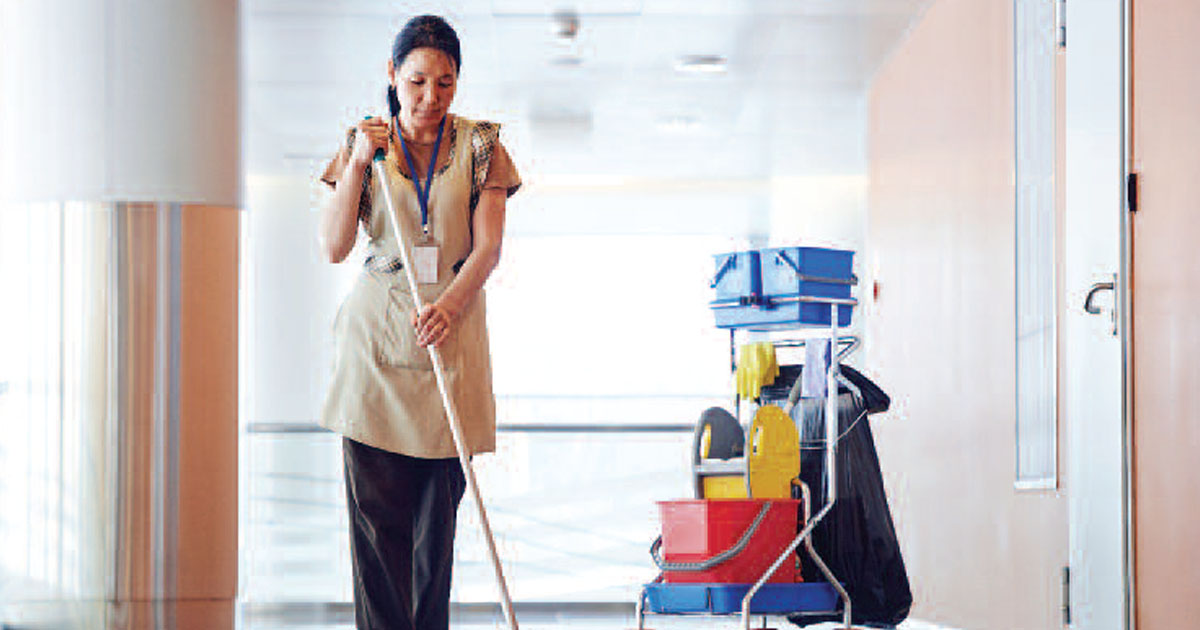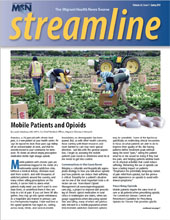
Shortly after Marta began her job cleaning hotel rooms around two years ago, she began having trouble breathing. She assumed it was part of getting older, and perhaps because she didn’t exercise, and ignored it, until recently, when cleaning even just one hotel room made her short of breath. When her primary care provider diagnosed her with chronic obstructive pulmonary disease, she was shocked — her grandfather, who smoked daily, had COPD. She had never smoked. With no training on chemical safety and limited access to protective equipment like face masks, Marta did not know she was at risk for respiratory illnesses from the cleaning products she used that contain substances such as irritant aerosols and bleaching agents.
Maintenance and cleaning workers are one group of workers that is regularly exposed to chemicals on the job, and those workers’ health is at risk without proper training and protection. Earlier this year, Alma Galván, MCH, Senior Program Manager for MCN joined co-facilitator Leslie Diaz, LMSW, MCN’s Health Network Associate and Coordinator of the Austin, Texas Ventanilla de Salud, to train Austinarea community health workers on chemical safety and workers’ rights and responsibilities among specific groups of workers, including hotel cleaners, as part of MCN’s Chemical Hazards and Hazard Communication in the Workplace project.
“There are lot of different factors that can lead to illness and injury from chemicals in the workplace,” Galván noted. “Workers are often not trained. They may also not feel they need to wear personal protective equipment — like gloves and masks — because it interferes with their ability to do the work fast.” Hotel cleaners, for example, are under pressure to clean a set of rooms over a specific period of time, leading workers to increase their speed and, at times, also increase their risk. Such work pressures, lack of chemical safety communication, and lack of protective equipment are common among restaurant employees, farmworkers, landscapers, and construction workers as well. Compounding the risk are language barriers and cultural divides.
MCN’s new wide-ranging and geographically diverse project, supported by the Susan Harwood Training Grant Program of the Occupational Safety and Health Administration (OSHA), seeks to equip workers like Marta to prevent work-related chemical illness and injury. Minority workers, particularly Latinos, are overrepresented in high hazard industries like agriculture and construction. Many of these hard-to-reach workers encounter occupational risks. Many have not received health and safety training and have fewer workplace protections than workers in other industries. This project addresses chemical safety and hazard communication to alleviate some of that risk among those who use chemicals like cleaning agents and pesticides.
Far Reaching Effort
MCN is utilizing our nationwide network of Community Health Workers, our partnership with the Ventanilla de Salud, and our longstanding relationships with Puerto Rican health centers to assure a broad reach throughout the country. Galván and Diaz’s first in-person training took place at Austin’s Ventanilla de Salud, a program housed within Consulates General of Mexico in each of the 50 states that provides health resources, counseling, and referrals to local health services. That training came shortly after a nationwide webinar in which Galván and Diaz provided a virtual chemical safety training for health promoters at Ventanilla offices around the US. In April, MCN headed to Dallas for a national meeting of Ventanilla coordinators, where they elaborated on topics first covered in the January webinar.
“The Ventanilla is such a key point of information dissemination for the Spanish speaking community, as many consider consulates an extension of their homes,” Diaz explained. Diaz will continue to bring chemical safety to the Austin Ventanilla, providing ongoing trainings in the coming months directly to local workers and employers. “These employees are what keep our infrastructure going. This is why it is so necessary that we work to keep important safety information in their hands,” Diaz emphasized. “We are one part of a system that helps them maintain their health for themselves and for the community at large.”
Concurrent with the Ventanilla trainings, Amy K. Liebman, MA, MCN’s Director of Environmental and Occupational Health, joined Galván for in-person trainings in Puerto Rico. Using a “train-the-trainer” model, 20 community health workers were provided with similar in-depth trainings on chemical safety and communication to then go and train workers across the island.
“Our work in Puerto Rico and our commitment to the island’s workforce builds on MCN’s deep partnerships with community health centers and groups across the island,” Liebman said.
At our partner Ventanilla de Salud in Austin and with our partner health center, Hospital General Castañer, in Puerto Rico, outreach workers and CHWs will offer area workers health and safety trainings. In all, MCN plans to reach a total of 800 CHWs and workers this year, strengthening skills to negotiate risk in the workplace, minimize chemical exposures and stay safer on the job.
Communicating the Risk: What We Share With Community Health Workers
MCN focuses on how CHWs can communicate the risk and help workers minimize their exposure. Part of the challenge for workers is identifying the risks. There is a wide range of chemicals, each of which may come in a variety of forms (gas, liquid, or solid). The routes of exposure to chemicals vary. Additionally, each worker will have a different level of risk based on their body size, age, and gender. A woman of childbearing age or a child whose brain is still developing are more susceptible to chemical exposure, and a female or young worker — or a worker who may bring chemicals on their clothing back to a family member of this sort — may need greater protection to avoid health consequences of exposure.
MCN trainers discuss the hierarchy of controls for occupational safety when explaining ways minimize the risk of exposure. The most effective way to minimize risk is to eliminate it, rarely an immediate option for workers. Substituting the chemical for one that is less toxic, emphasizing engineering controls to avoid exposures, and offering administrative controls such access to safety data sheets and worker safety training are part of the hierarchy. Use of personal protective equipment is also stressed.
“In many workplaces, the total elimination of chemicals is rarely a possibility, but exposure can be minimized with safety training and proper and regular use of PPE,” Liebman said.
The MCN training also covers rights and responsibilities for both employees and employers. Part of the CHW training is to help workers understand what their employers are required to provide in terms of chemical safety. Throughout the trainings, an emphasis is placed on empowerment of the worker. “Employees in all industries have ‘the right to know’ — to know about the chemical risks in the workplace, with information provided in their language,” Galván asserted.
Selected Resources:
MCN’s recent webinar, “It’s Your Right to Know! Helping Community Health Workers Promote Chemical Safety on the Job” is archived:
In English: https://goo.gl/FYNJmu
In Spanish: https://goo.gl/y18E2a
MCN’s Bilingual Picture Dictionary, “Seguridad en Palabras/ Safety in Words,” illustrates workplace hazards and best practices for health and safety in agriculture is available at
MCN’s numerous environmental and occupational health resources are available at
Ventanilla de Salud’s website is
Read this article in the Spring 2018 issue of Streamline here!
Sign up for our eNewsletter to receive bimonthly news from MCN, including announcements of the next Streamline.
